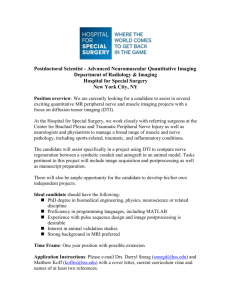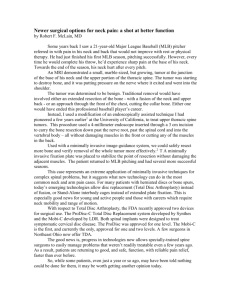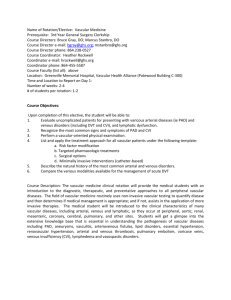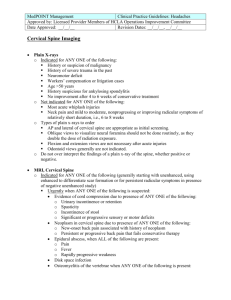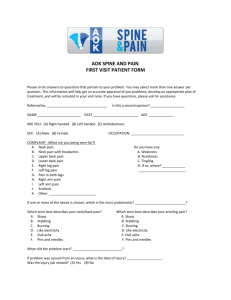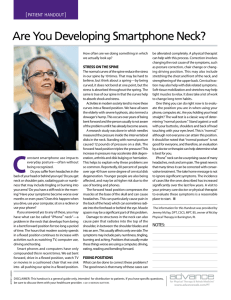NEURORADIOLOGY STUDY GUIDE Outlined below are the general
advertisement
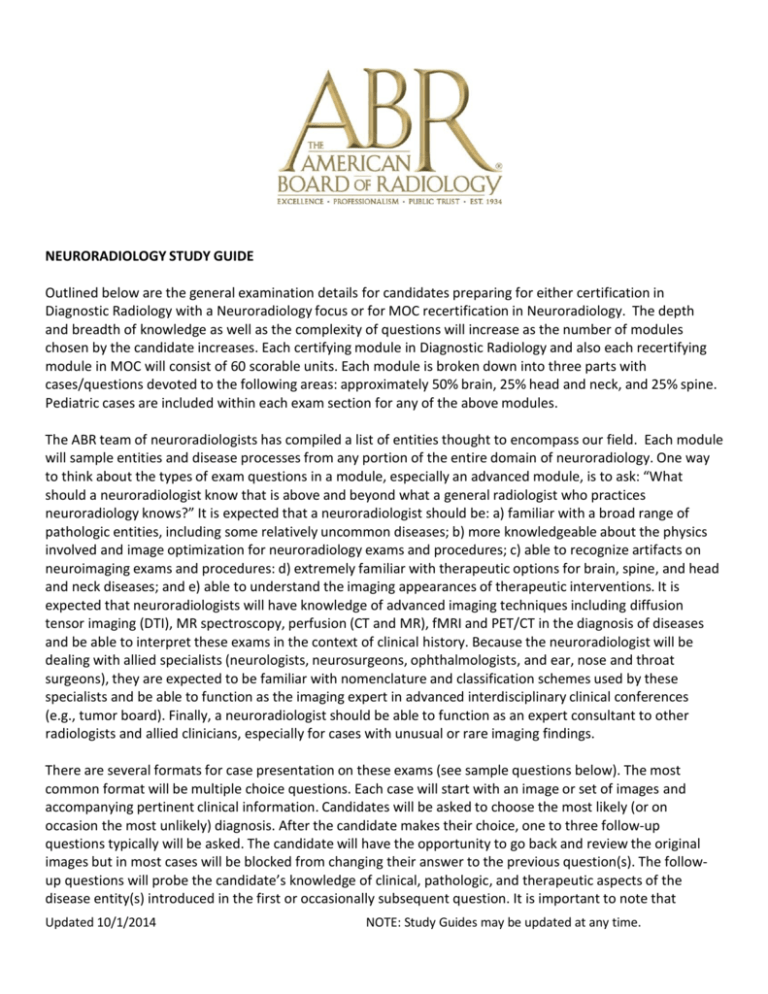
NEURORADIOLOGY STUDY GUIDE Outlined below are the general examination details for candidates preparing for either certification in Diagnostic Radiology with a Neuroradiology focus or for MOC recertification in Neuroradiology. The depth and breadth of knowledge as well as the complexity of questions will increase as the number of modules chosen by the candidate increases. Each certifying module in Diagnostic Radiology and also each recertifying module in MOC will consist of 60 scorable units. Each module is broken down into three parts with cases/questions devoted to the following areas: approximately 50% brain, 25% head and neck, and 25% spine. Pediatric cases are included within each exam section for any of the above modules. The ABR team of neuroradiologists has compiled a list of entities thought to encompass our field. Each module will sample entities and disease processes from any portion of the entire domain of neuroradiology. One way to think about the types of exam questions in a module, especially an advanced module, is to ask: “What should a neuroradiologist know that is above and beyond what a general radiologist who practices neuroradiology knows?” It is expected that a neuroradiologist should be: a) familiar with a broad range of pathologic entities, including some relatively uncommon diseases; b) more knowledgeable about the physics involved and image optimization for neuroradiology exams and procedures; c) able to recognize artifacts on neuroimaging exams and procedures: d) extremely familiar with therapeutic options for brain, spine, and head and neck diseases; and e) able to understand the imaging appearances of therapeutic interventions. It is expected that neuroradiologists will have knowledge of advanced imaging techniques including diffusion tensor imaging (DTI), MR spectroscopy, perfusion (CT and MR), fMRI and PET/CT in the diagnosis of diseases and be able to interpret these exams in the context of clinical history. Because the neuroradiologist will be dealing with allied specialists (neurologists, neurosurgeons, ophthalmologists, and ear, nose and throat surgeons), they are expected to be familiar with nomenclature and classification schemes used by these specialists and be able to function as the imaging expert in advanced interdisciplinary clinical conferences (e.g., tumor board). Finally, a neuroradiologist should be able to function as an expert consultant to other radiologists and allied clinicians, especially for cases with unusual or rare imaging findings. There are several formats for case presentation on these exams (see sample questions below). The most common format will be multiple choice questions. Each case will start with an image or set of images and accompanying pertinent clinical information. Candidates will be asked to choose the most likely (or on occasion the most unlikely) diagnosis. After the candidate makes their choice, one to three follow-up questions typically will be asked. The candidate will have the opportunity to go back and review the original images but in most cases will be blocked from changing their answer to the previous question(s). The followup questions will probe the candidate’s knowledge of clinical, pathologic, and therapeutic aspects of the disease entity(s) introduced in the first or occasionally subsequent question. It is important to note that Updated 10/1/2014 NOTE: Study Guides may be updated at any time. questions may refer to entities other than the “correct” diagnosis of the case. In some circumstances, followup questions will include additional images or imaging from another modality that may alter the most likely diagnosis of the case. Another style of question is an item-matching case. In this format, the candidate will be given a list of seven or more diagnostic options and separate questions consisting of one or more images, which may or may not include a brief clinical history. For each question and image(s), the candidate will match it to the correct diagnostic option from the list. The diagnostic options may be used once, more than once, or not at all. This format is used to test the candidate’s ability to differentiate between lesions with similar appearances or locations. The third format will be questions focused on neuroradiology anatomy. The candidate will be shown an image and will be asked to place a label over the region of interest of a specific anatomic structure. Outlined below is a general list of the topics in Neuroradiology that may be covered in a module. Please note that this list covers basic themes and concepts and does not encompass every specific entity that could possibly be covered in a module. Neuroanatomy o Brain (including hemispheres, brainstem, cranial nerves, sella/parasellar region, ventricular system, and functional areas, etc.) o Spinal Canal, Spine, and Pertinent Paraspinal Structures o Structural Head and Neck (including oropharynx, nasopharynx, orbits, skull base, salivary glands, sinuses, temporal bone, thyroid gland, larynx, parapharyngeal space, hypopharynx) o Vascular (including carotid and vertebrobasilar extracranial arterial and venous system, intracranial arterial and venous system, spinal cord arterial and venous system, blood-brain barrier function, dural sinus drainage) Physiology o Function of Specific Structures and Regions of the Brain and Related Areas (including cerebral and cerebellar areas, cranial nerves, spinal cord, related peripheral nerve distribution, etc.) o Vascular Phenomena (including arterial and venous flow, blood-brain barrier, local perfusion, regional zones of vascular supply and drainage) o Reactive Phenomena (including edema, tissue perfusion, toxic insult and externally administered biologic and physiologic contrast agents used in imaging) Pathology o Neoplasm (including primary and secondary tumors of the cerebrum, cerebellum, cranial vault, spine and spinal cord, head and neck) Intra-axial and extra-axial neoplasms Adult and pediatric neoplasms Non-neoplastic tumorous conditions o Vascular disease (including stroke, hemorrhage, atherosclerosis, vascular malformations and aneurysms, congenital vascular abnormalities, vasculitis, concepts of functional blood flow, blood-brain barrier phenomena, dynamic blood flow imaging, venous infarction, border zone infarction, and hypoxia/anoxia) o Infection (including pathogens of bacterial, viral, fungal, prion and parasitic origin) Anatomic and physiologic considerations including concepts of abscess, leptomeninges, blood-borne sepsis, ventriculitis, sinusitis, etc. Specific anatomic relationships in the brain, spine, orbit, sinus and neck Updated 10/1/2014 NOTE: Study Guides may be updated at any time. White matter disorders and noninfectious conditions of inflammation (including demyelination, collagen vascular disease and autoimmune response) o Metabolic, degenerative, reactive and toxic disorders o Hydrocephalus and cysts o Trauma (including classifications of head, head and neck, and spine injury; anatomic considerations of intracranial, hemispheric, brainstem, cranial vault, neck, spine and vertebral column, and spinal cord injury) Gross and microscopic axonal injury External factors for injury Child abuse, toxic, radiation o Congenital disorders (including conditions in the brain, spine, head and neck, skull, neuronal migration, phakomatoses, hamartomatous malformations, genetic-based disorders, dysplasias) o Head and neck (including disorders of the sella/parasellar region, orbit, sinuses, facial bones, temporal bone, cerebellopontine angle/internal auditory canal, salivary system, nasopharynx, oropharynx, hypopharynx, larynx, thyroid gland, and skull base) o Spine and spinal disorders (including degenerative, neoplastic, congenital, infectious/inflammatory, traumatic and vascular) o Pediatric disorders, including perinatal and neonatal entities o Miscellaneous disorders that do not clearly fit into any of the above categories. For example, postoperative changes including reconstruction, medication, and post-therapy effects Clinically related disease information o Clinical presentations of neuropathologic conditions o Basic laboratory supportive information o Historical profiles of disease presentation o Relationship to other clinically related disciplines, involving imaging needs in neurology, neurosurgery, otolaryngology, orthopedics, endocrinology, pediatrics, and emergency medicine Functional technology in neuroimaging o Modalities (including computed tomography; magnetic resonance imaging including functional, spectroscopic, diffusion/perfusion, tensor and angiography; invasive and noninvasive angiography; myelography, ultrasound, nuclear radiology, radiography) o Updated 10/1/2014 NOTE: Study Guides may be updated at any time. SAMPLE QUESTIONS: SINGLE-ANSWER MULTIPLE CHOICE QUESTION: 1. A 72-year-old patient presents with left facial pain. The images show what vascular anomaly? A. B. C. D. Persistent trigeminal artery Persistent hypoglossal artery Persistent dorsal ophthalmic artery Persistent primitive olfactory artery SINGLE-ANSWER MULTIPLE CHOICE QUESTION WITH BLOCKED FOLLOW-UP QUESTION: 2a. A 51-year-old Chinese man has a 1-year history of otalgia. He presents with a palpable neck mass. Based on the images, in addition to lymphadenopathy, what is the most likely diagnosis? A. Mastoiditis B. Nasopharyngeal carcinoma C. Supraglottic carcinoma Updated 10/1/2014 NOTE: Study Guides may be updated at any time. D. Cat scratch disease BLOCKED RETURN: The candidate cannot go back and change the answer after proceeding to the next question. But one can go back and review the question and images. 2b. Nasopharyngeal carcinoma is most commonly associated with which of the following infections? A. B. C. D. E. Epstein-Barr virus Varicella zoster virus Parvovirus Human papillomavirus Coxsackie virus EXTENDED MATCHING OR “R-TYPE" QUESTION: 3. For each patient, select the most likely clinical scenario. Each option may be used once, more than once, or not at all. Option List: A. 3-year-old child with altered mental status B. 10-year-old child with seizures since birth C. 30-year-old patient involved in a motor vehicle collision, no skull fracture D. 70-year-old patient with a history of multiple falls E. Acute mental status change, dehydration F. Dementia G. Severe hypertension with sudden headache H. Trauma with skull fracture I. “Worst headache of life” 3a. Patient A Updated 10/1/2014 3b. Patient B NOTE: Study Guides may be updated at any time.

